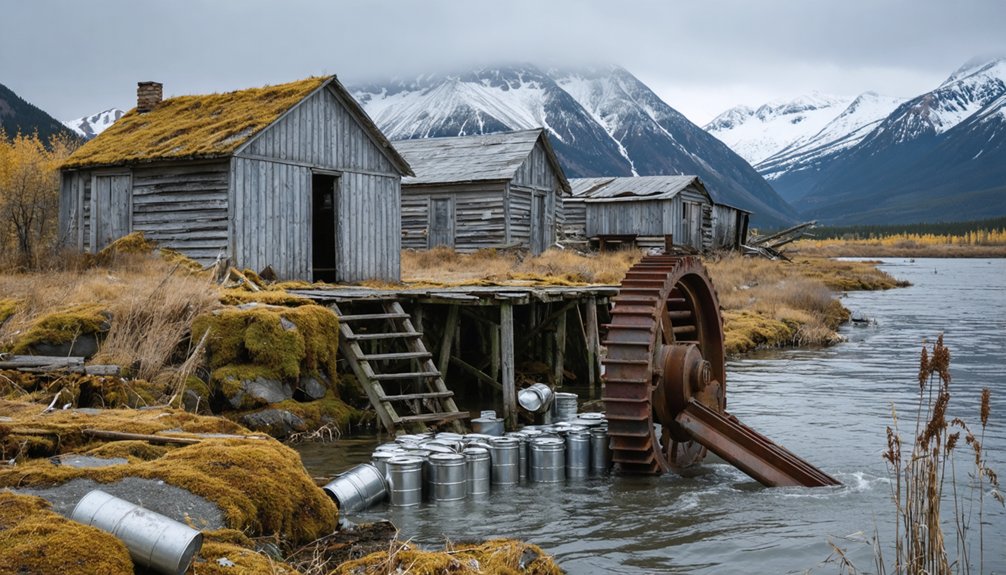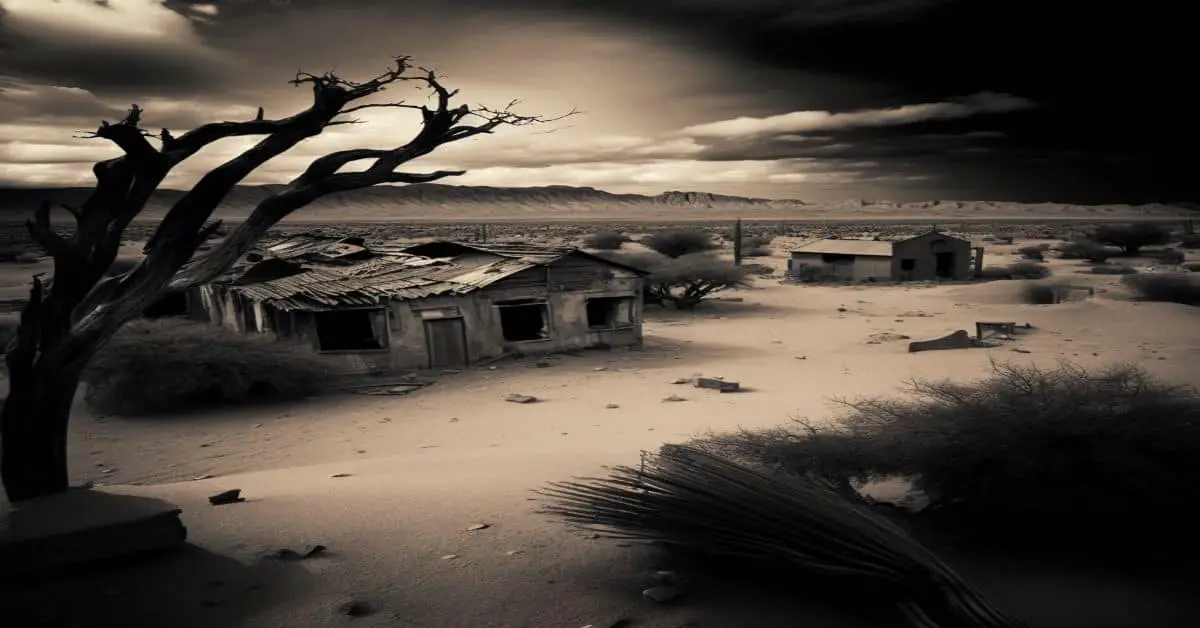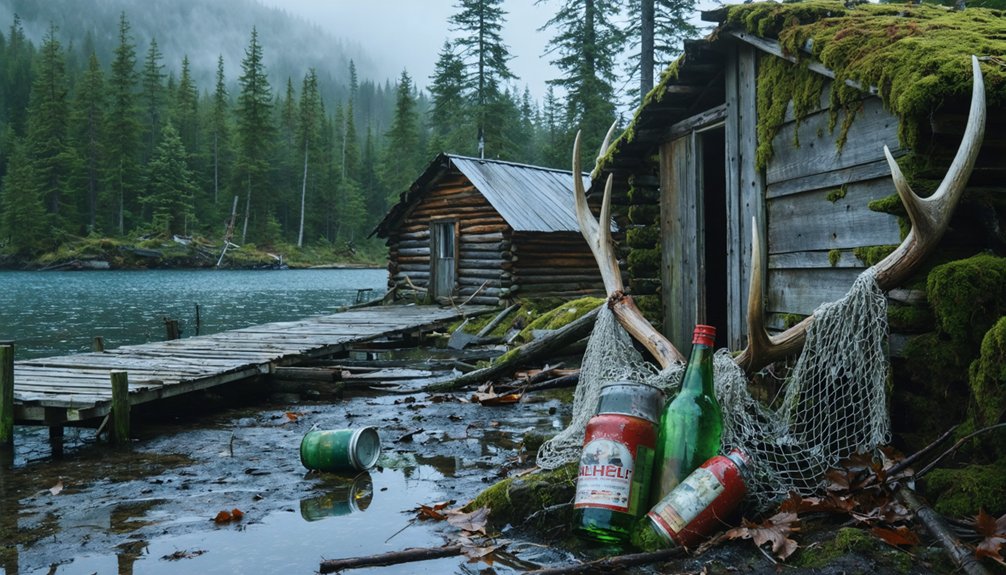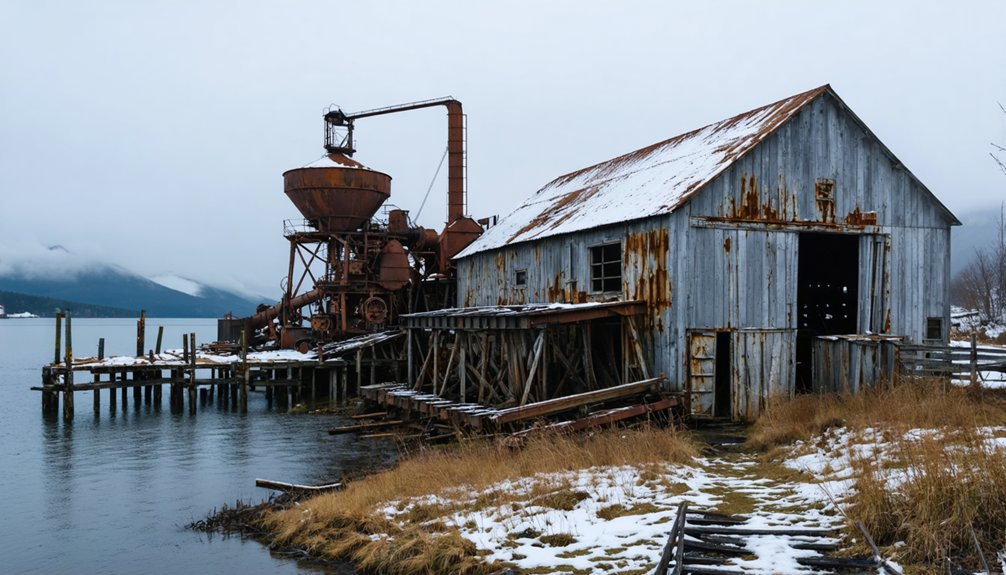You’ll find Ohagamiut along Alaska’s Kuskokwim River, where this ancient Yup’ik settlement thrived for centuries before its abandonment in the 1940s. The village’s origins trace back to eastern Siberian migrations, with Russian explorers first documenting it in 1818. Disease outbreaks, especially the 1918 flu pandemic, triggered population decline, forcing families to relocate. The site now holds archaeological significance, with church foundations and artifacts revealing the complex story of cultural transformation.
Key Takeaways
- Ohagamiut was a significant Yup’ik settlement along Alaska’s Kuskokwim River that became abandoned in the 1940s after centuries of habitation.
- The 1918 flu pandemic severely impacted the population, contributing to the community’s eventual abandonment and resident relocation.
- Archaeological remains include church foundations from the first Roman Catholic mission in western Alaska, established in 1892.
- Former residents dispersed to nearby communities including Kalskag, Aniak, and Bethel, where their descendants maintain cultural connections.
- The site demonstrates the transition from traditional Yup’ik life to Russian Orthodox and American influences before becoming a ghost town.
Origins of a Yup’ik Settlement
While the origins of Ohagamiut trace back to ancient Yup’ik migrations, the settlement’s story begins roughly 10,000 years ago when the Yup’ik ancestors crossed the Bering Land Bridge from eastern Siberia into Alaska.
By 3,000 years ago, they’d established themselves along western Alaska’s coast, eventually moving inland along the Yukon and Kuskokwim rivers around 1400 C.E.
You’ll find that the traditional architecture of early Yup’ik settlements reflected their sophisticated social organization.
They built qasgiq, communal buildings for gatherings and ceremonies, alongside ena structures where families lived. Serving as vital community spaces, these qasgiq buildings were used as workshops and teaching spaces.
These settlements thrived on a rich diet of sea mammals, caribou, and salmon.
When Russians arrived, bringing European goods and new diseases, they forever changed the fabric of Yup’ik life, though the community’s cultural foundations remained resilient.
The first documented evidence of the settlement came in 1818 from Russian explorers who encountered the village along the Kuskokwim River.
Life Along the Kuskokwim River
The Kuskokwim River shaped every aspect of life for Ohagamiut’s residents, offering both sustenance and connection to the wider world. Drawing from the region’s placer gold deposits, miners established outposts along the riverbanks during the early 1900s. The massive waterway stretches 724 miles long, carving through western Alaska’s diverse terrain.
Like other Yup’ik settlements along this mighty waterway, you’d find the community deeply connected to seasonal rhythms that governed travel and subsistence fishing practices. The river served as their lifeline, supporting a rich cultural heritage through traditional hunting, fishing, and gathering activities.
- In summer, you’d navigate by boat to access prime fishing spots and neighboring villages.
- Winter transformed the frozen river into an ice road for snowmachines and vehicles.
- You’d rely on salmon runs and other river resources for year-round sustenance.
- With no connecting roads, you’d depend on air travel and river transport to reach major hubs like Bethel.
Russian Influence and Cultural Changes
Russian influence reached Ohagamiut through the expanding fur trade network established by the Russian-American Company after 1799.
You’ll find evidence of this influence in the Orthodox Christian traditions that took root along the Kuskokwim River, where native communities adapted Russian religious practices while maintaining their cultural identity. The promyshlenniki’s presence brought significant changes to local trade dynamics and social structures. Three Saints Bay at Kodiak Island served as the first major Russian settlement that initiated this expansion into Alaska.
Russian architecture became visible through the construction of Orthodox chapels, which served as both religious and cultural centers for the community. Indigenous peoples faced land encroachment and exploitation from Russian settlers during this period.
You can trace the cultural syncretism that emerged as indigenous peoples incorporated Russian customs, language, and material goods into their daily lives while trading furs. This blending of cultures shaped Ohagamiut’s development until Alaska’s sale to America in 1867.
The Final Days of a Native Village
You’ll find that Ohagamiut’s final days in the 1950s-1960s saw its remaining families gradually relocate to larger communities for better economic and educational opportunities.
The village’s last active residents maintained traditional subsistence practices while possible, but declining local resources and lack of modern amenities made staying increasingly difficult. Today, the site along the right bank Yukon serves only as a seasonal fish camp. Many families preserved their cultural heritage through knowledge systems documentation maintained by organizations dedicated to Alaska Native traditions.
The Orthodox Church remained an essential cultural touchstone until the end, with families participating in traditional ceremonies even as they prepared for their inevitable departure to places with more services and infrastructure.
Community Migration Patterns
During the early 20th century, Ohagamiut’s population experienced dramatic shifts that ultimately led to its abandonment, driven by a complex interplay of epidemics, economic pressures, and missionary influence.
Despite generations of community resilience through seasonal migrations, you’ll find that external forces dramatically reshaped traditional Yup’ik settlement patterns.
- The devastating 1900-01 epidemic forced survivors to consolidate in larger settlements with access to medical care.
- Mission schools and trading posts drew families away from traditional camps toward permanent settlements.
- Introduction of Western goods and firearms disrupted established hunting and trapping practices.
- The gold rush era created economic opportunities elsewhere, pulling residents toward mining regions.
These migration patterns reflected both voluntary adaptations and necessary responses to survive in a rapidly changing environment.
Last Active Families
The final handful of families remaining in Ohagamiut through the 1940s maintained traditional Yup’ik subsistence patterns while grappling with increasing isolation and limited access to modern services. Their subsistence strategies centered on hunting and fishing along the Kuskokwim River, with men pursuing game while women processed the catch.
Despite maintaining clan dynamics and some traditional spiritual practices, these last residents faced mounting challenges that would ultimately drive them to relocate.
You’ll find that deteriorating infrastructure, limited medical care, and harsh living conditions gradually pushed these families toward larger communities like Kalskag, Aniak, and Bethel.
While they’d preserved elements of their cultural heritage, including shamanic traditions that persisted alongside Catholic influences, the practical demands of survival in an increasingly modernizing Alaska proved insurmountable.
Life Before Departure
As pressures mounted on Ohagamiut’s remaining families in the mid-20th century, daily life centered around increasingly difficult efforts to maintain traditional subsistence patterns while dealing with deteriorating conditions.
You’d find villagers still practicing resource management through seasonal fishing and hunting, but with growing challenges. Environmental changes and erosion threatened historic sites while infrastructure deficits made daily life more challenging.
Despite these pressures, traditional practices endured through oral histories and community gatherings.
- Families continued salmon fishing and hunting cycles along the Kuskokwim River
- Elders maintained cultural knowledge through storytelling and ceremonies
- Russian Orthodox Christian influences blended with Native customs
- Local trading persisted but declined as residents began looking toward larger communities
Legacy in Modern Alaska
Since its abandonment in the 1940s, Ohagamiut’s legacy persists through dispersed Yup’ik families who relocated to communities like Kalskag, Aniak, and Bethel.
You’ll find their cultural identity maintained through oral histories, family gatherings, and community events that connect descendants to their ancestral village.
Like many communities affected by the 1918 flu pandemic, Ohagamiut faced significant population decline before its eventual abandonment.
While the physical site has transformed due to industrial activities and environmental changes, Ohagamiut’s story lives on in digital archives and historical databases.
Though Ohagamiut’s physical presence has faded, its historical footprint endures through modern preservation in digital collections and archives.
You’ll sometimes see it referenced in academic discussions about Alaska’s settlement patterns, though it’s occasionally confused with Ohogamiut on the Yukon River.
Despite the lack of formal preservation efforts at the site, the economic adaptation of former residents and their descendants reflects the broader evolution of rural Alaska’s indigenous communities, as they’ve balanced traditional values with modern realities.
Archaeological and Historical Significance
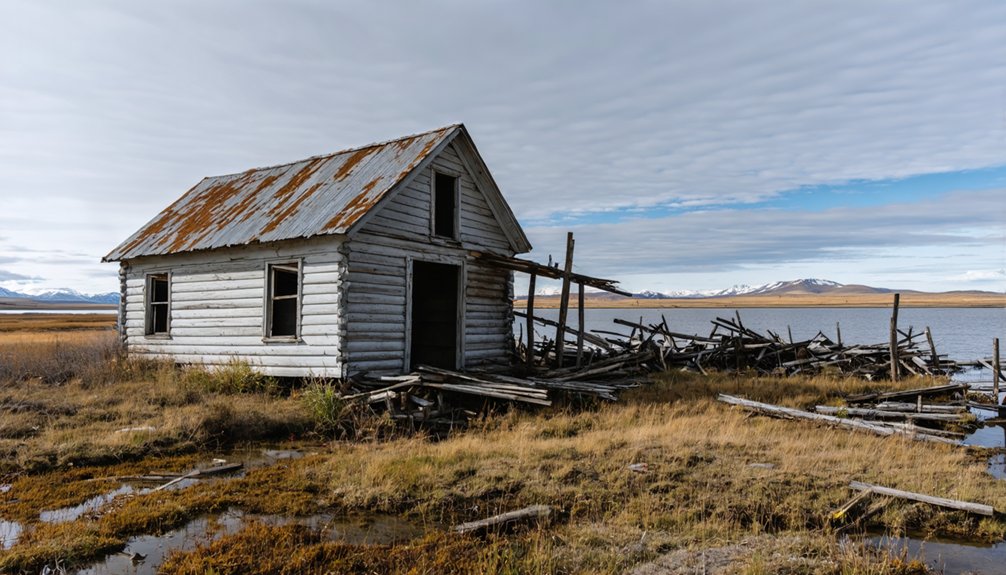
Originally documented by Russian explorers in 1818, Ohagamiut emerged as a significant Yup’ik settlement along the Kuskokwim River with profound archaeological value.
Through archaeological findings and cultural artifacts, you’ll discover evidence of indigenous life, Russian colonial influence, and the dramatic cultural shifts that shaped this historic settlement. Similar to how personal items remained when Kennicott was abandoned, Ohagamiut’s artifacts provide a snapshot of daily life frozen in time.
- The site’s church foundations reveal the first Roman Catholic mission in western Alaska, established in 1892.
- Archaeological excavations showcase the integration of traditional Yup’ik practices with Russian and American influences.
- Cultural artifacts demonstrate the evolution from shamanic traditions to Christian religious practices.
- The village layout and material remains provide essential insights into pre-contact and post-contact indigenous life.
You can trace the settlement’s transformation from a thriving Yup’ik community to its eventual abandonment in the 1940s through these preserved remnants.
Frequently Asked Questions
What Was the Peak Population of Ohagamiut Before Its Abandonment?
Like a blooming flower before winter’s frost, you’ll find Ohagamiut history reveals its highest population reached 130 residents in 1880, before population decline led to eventual abandonment in the 1940s.
Are There Any Artifacts From Ohagamiut Displayed in Alaskan Museums?
You won’t find documented artifacts from this village in major Alaskan museum exhibits. While museum artifact preservation efforts cover Yup’ik culture broadly, specific items from this location aren’t currently displayed.
What Traditional Yup’ik Ceremonies Were Specifically Practiced in Ohagamiut?
Like ancestral footprints in fresh snow, you’ll find the Agayuliyaraq, Elriq, and Nakaciuq ceremonies were central to Yup’ik spirituality and ceremonial practices, with masked dances performed regularly in Ohagamiut’s qasgiq.
Did Any Non-Native Americans Ever Permanently Settle in Ohagamiut?
No, you won’t find evidence of non-native agriculture or permanent early settlers there. Beyond Russian missionaries and Catholic mission staff, records show only temporary visits by non-Native Americans, never permanent residency.
What Natural Resources Besides Fish Were Harvested Around Ohagamiut?
You’ll find they did timber harvesting along the Kuskokwim River, trapped wildlife like beaver and muskrat, gathered wild berries and plants, and occasionally mined nearby areas for minerals.
References
- https://repository.si.edu/bitstream/handle/10088/15489/bulletin1991967smit.pdf
- https://alchetron.com/Ohagamiut
- https://blog.batchgeo.com/ghost-towns/
- https://en.wikipedia.org/wiki/List_of_ghost_towns_in_Alaska
- https://www.arlis.org/docs/vol1/BLM/1985/761126432.pdf
- http://ankn.uaf.edu/Resources/mod/glossary/view.php?id=28&mode=cat&hook=&sortkey=&sortorder=asc&fullsearch=0&page=77
- https://library.alaska.gov/hist/hist_docs/docs/asl_F901_A295_no_7_web.pdf
- https://en-academic.com/dic.nsf/enwiki/517195
- https://en.wikipedia.org/wiki/Ohagamiut
- https://archaeology.org/issues/september-october-2015/features/alaska-yupik-cultural-revival/
